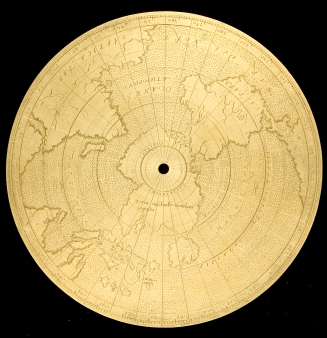| Date | 1600 |
| Maker | François Morillard |
| Place | Narbonne |
| Material | Gilt brass |
| Inventory no. | 53966 |
| Acquisition | Presented by J. A. Billmeir in 1957 |
In the sixteenth century, astrolabe makers increasingly constructed geographic astrolabes, which included a stereographic projection of the terrestrial globe on one or more plates in place of the more typical projection of the celestial sphere.
The remarkable feature of this instrument is the southern projection of the terrestrial sphere. Most geographic astrolabes use a north polar projection that depicts the terrestrial globe on a horizontal plane that touches the globe at the north pole. Indeed, the other side of the plate shown in the picture adopts just such a projection. This plate, however, reverses the projection. The point of view remains from the north looking south, but now the plane of projection is horizontal and tangent to the earth at the south pole. The result shows Madagascar to the left of Africa and the Atlantic Ocean and South America to the right. It is also worth noting the relative accuracy of this map. By 1600, the date of manufacture, very little of Australia was known, yet it is easily recognizable below the Malaysian archipelago.
The astrolabe currently has just one other plate, added for a later owner by the late 17th-century Parisian maker Pierre Sevin. The plate is for the latitude of Paris (48° 52') on one side, and carries a De Rojas universal projection on the other. Sevin has added not only the plate but a regula, cursor and brachiolum to be used with it.
View all
images for this astrolabe
View
detailed provenance for this astrolabe
Mater
The mater and limb are of one-piece construction. Scales on the limb: equal hours scale; degree scale.The limb is inscribed: with a direction marked as SYROCCHO LEVANTE GRECO TRAMONTANO MAGISTRAL PONENTE LEBECCIO. Directions indicated by the names of the winds.. More information
Back
The back contains 11 scales of the following types: Altitude; Zodiacal signs; Calendar; Windrose; Dominical letter; Solar cycle; Golden number; Epact; Perpetual calendar; Shadow square. The back is inscribed: with a maker's signature marked as Fr. Morillard Lugdunen. faciebat Narb. Anno M.VIc (Fr. Morillard of Lugdunen made it at Narbonne, 1600). More informationRete, Nut & Bolt
The rete contains 17 stars. The zodiac on the rete is labelled: ARIES ♈ , TAVRVS ♉ , GEMINI ♊ , CANCER ♋ , LEO ♌ , VIRGO ♍ , LIBRA ♎ , SCORPIVS ♏ , SAGITTARIVS ♐ , CAPRICORNVS ♑ , AQVARIVS ♒ , PISCES ♓ .The rete is attached using a nut & bolt. The bolt is attached to the regula, a later addition to the instrument. The nut is a small round nut.. More information
Rules & Alidades
| Type | Details |
|---|---|
| Alidade | Double-ended. |
| Regula | Double-ended. This regula still has the cursor and a
small brachiolus. |
| Rule | Double-ended, counter-changed. |



